Top 20 Engineer’s mindset for growth that you should develop now.
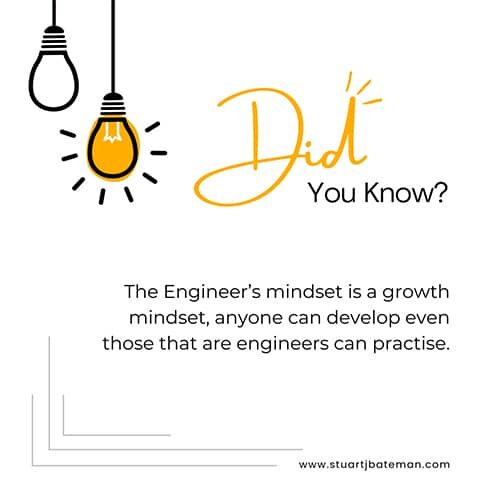
To focus on what can be controlled – The obstacle is the way
The Engineer’s mindset #1
I’ve been thinking for a while now about what makes an engineer (in my opinion anyway) and I’ve come up with a few ideas as to the engineer’s mindset, maybe you agree or not? let me know!
Anyway, let’s start #1 Engineer’s have a natural curiosity about the world which leads us to play/tinker with things and ask questions to figure out how they work, without this skill I couldn’t design or solve a problem unless I had a working knowledge that I can apply science behind it.
It’s also a trait of many other fields, so if you think it’s part of your mindset in another field, shout it out!

Engineer’s mindset #2
Engineers possess a methodical approach to resolving problems, employing techniques like FMEA, 5Y, 8D, DMAIC, PDCA, RCA, etc. However, we also embrace a practical mindset by directly engaging with the problem at hand, except in cases where it may be dangerous.
There is a significant value in attempting solutions while directly facing the issue, although there are instances where we require data to analyse problems that are not visible or occur intermittently.
Let me know your experiences or thoughts about this process!
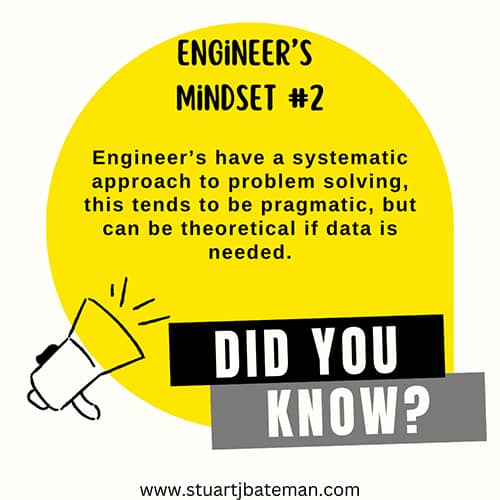
Engineer’s Mindset #3
Greetings on this Tuesday! It’s time for another edition of “Did you know?”
Collaboration is at the heart of an engineer’s work. It’s through teamwork that we accomplish remarkable feats, and honestly, it’s where I’ve experienced the most significant growth—learning from seasoned, skilled, and talented individuals throughout the years.
Within a team of engineers, ideas reverberate through the room, undergoing scrutiny, analysis of physics, exploration of potential solutions, and consideration of how they can be implemented. The crux lies in this collaborative dynamic. I’ve never encountered a group of engineers that concluded a problem was insurmountable or shied away from a challenge. In our world, challenges are opportunities for innovation.
Let me know your experiences or thoughts about this process!

Engineer’s Mindset #4
Built your solution and test it
- What went wrong?
- What worked?
- What could you change?
- Focus on one variable at a time.
Now, to develop as an Engineer we need to learn to get feedback for our thoughts:
- Go ask your Manager
- Go ask your peers
- Go ask someone from another department
- Go ask someone who will be working with your solution
Don’t be afraid of failure, through it we learn and grow with the help of others offering critical feedback and insights.
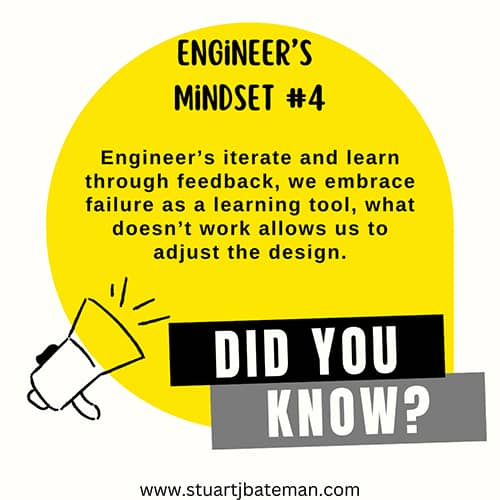
Mindset #5
Ever wondered why engineering solutions are rarely straightforward?
Solutions in engineering are rarely black and white; they require a nuanced approach.
- Structural Design: Balancing strength with cost.
- Electrical Engineering: Compromising between energy efficiency and infrastructure expenses.
- Mechanical Engineering: Finding the right balance between speed and torque.
- Chemical Engineering: Optimizing processes while minimizing environmental impact.
- Software Engineering: Juggling speed and memory usage efficiently.
Remember, the art of compromise is not a weakness; it’s a strategic strength that allows us to navigate the complexities of engineering and deliver solutions that stand the test of reality.
As an engineer we work together to solve the problems, find the compromise and deliver the project.
Where have you compromised to solve a problem?

Mindset #6
I failed, over and over.
But that’s ok, as I learnt to see failure in a different light
Engineer’s embrace failure, we don’t expect it but if it happens we don’t lose our focus and wonder what could have been, we jump in with our tools and devices to find out why the solution didn’t work.
You might think it’s just not engineer’s which is true, but the mindset we have wants to learn and failure is that chance to see if we were on the right path, need to think again or understand what variable didn’t work.
You don’t learn anything from success, it’s a great feeling but you only know that it work, now ask yourself
- Do you know where it will failed?
- What are the limits of its specifications?
- What if the material can’t be sourced, what happens if I change it?
Have I failed? – Of course!
I had to find out the limits for a press fixture that kept collapsing under a 5 ton fly press, my calculations for the bending moment was incorrect and the material needed to be a higher tensile strength.
So, from this I have a checklist that I go through when I design jigs and fixtures, depending on the application.
Have you failed and learnt from it? share down in the comments and lets learn from each other!
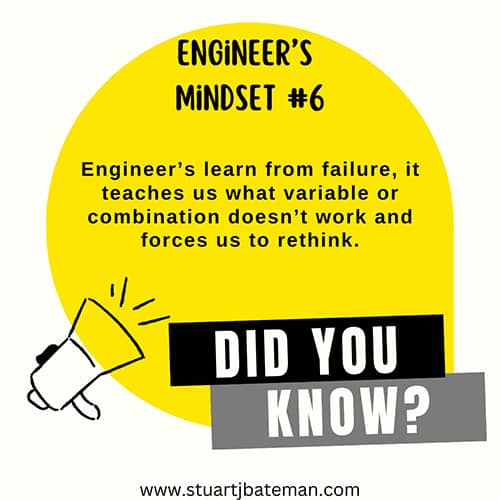
Mindset #7
In the realm of engineering, ensuring the effectiveness of a solution is paramount, be it within the controlled environment of a factory or the unpredictable conditions of the outdoors. Our approach? Rigorous testing—essential for success.
Testing to the Extreme:
To validate a solution’s resilience, we advocate testing to destruction whenever possible. When that’s not feasible, exhaustive testing becomes the norm. This involves a comprehensive examination of potential failure points, their sequence, and anticipated time frames.
Diverse Testing Methods:
- Laboratories (Labs): Utilizing controlled environments to simulate real-world conditions.
- NDT (Non-Destructive Testing): Employing methods that assess material integrity without causing damage.
- Custom Test Rigs: Designing and building specialized apparatus to evaluate specific variables.
- Scaled Models: Testing scaled-down replicas to gain insights into real-world performance.
- Research: Delving into the successes and pitfalls of previous and current solutions.
The Stakes Are High:
Given the diverse risks inherent in our work—some even involving human lives—emphasizing the importance of testing cannot be overstated. It serves as a driving force behind continuous improvement, setting standards, and ensuring top-notch quality.
So, what are your experiences with testing?
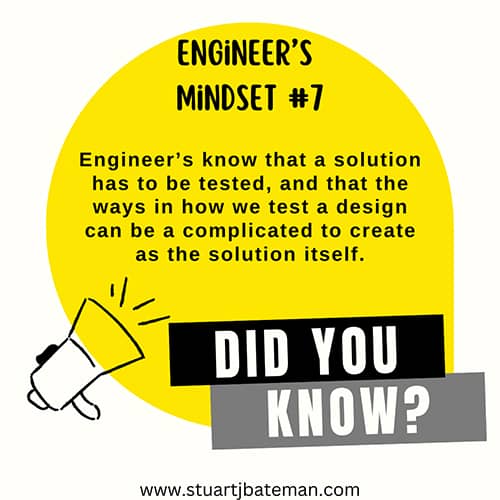
Mindset #8
Engineers thrive on teamwork, and going solo is a bit like finding a unicorn – it happens, but it’s rare! So, why the collective vibe?
Ever wondered why when engineers talk about their projects, it’s always a “We did” instead of “I did”?
Picture this: you’re in a team, and everyone’s got their unique spin on things.
That’s the magic sauce!
Here’s why we engineers dig opinions from different departments:
- Diverse backgrounds bring unique insights, shaping problem-solving approaches.
- Long-term engagement with a challenge equips team members with a depth of understanding and alternative ideas.
- Varied problem-solving methods introduce fresh perspectives, potentially unlocking innovative solutions.
- Experience from different companies offers alternative approaches to familiar challenges.
- Engaging in conversations sparks ideas, often originating from seemingly unrelated topics.
- Collective discussions provide a holistic viewpoint, revealing nuances that might be overlooked.
- Collaborative efforts strengthen bonds, fostering a sense of unity within teams and departments.
- Beyond immediate tasks, this approach aids in identifying both risks and opportunities.
Remember, even though departments do their thing, we’re all in this together. Asking for input isn’t just good for problem-solving; it’s like giving a shout-out to your work family!

Mindset #9
Engineers are renowned for their inquisitive nature—it’s practically in our DNA!
But what sets us apart in our questioning is the depth of curiosity we bring to understanding the very essence of the problems we aim to solve. We don’t just question external factors; we turn the spotlight inward, scrutinizing our own ideas, thoughts, and solutions with a keen eye.
To be fair, our interrogation extends beyond self-reflection. We engage in a collaborative process of evaluation, not only assessing our own concepts but also delving into the rationale behind the ideas and methodologies embraced by our fellow engineers within the team.
So, why do we embark on this relentless quest for answers?
It’s because we understand that the quality of our solutions is directly linked to the thoroughness of our understanding. By dissecting and analysing every facet of a problem or solution, we not only optimize our designs but also pave the way for innovation and progress in our field.
Here are 5 tools I use regularly:
- Failure Modes and Effects Analysis (FMEA): A systematic approach to identifying and mitigating potential failure modes within designs or processes, FMEA helps prioritize risk reduction efforts.
- Brainstorming Sessions: Collaborative idea generation sessions where team members freely share and explore creative solutions.
- SWOT Analysis: Structured evaluation of strengths, weaknesses, opportunities, and threats to assess idea feasibility.
- Decision Matrix Analysis: Systematic tool for comparing and prioritizing solutions based on predefined criteria.
- Prototype Development: Creating scaled-down versions to test functionality and gather feedback for refinement.
- Peer Review: Soliciting constructive feedback from team members to enhance solution quality and effectiveness.
But this doesn’t stop with Engineers; using methods like these within other professions will yield the same benefits. These tools empower teams to enhance the quality, efficiency, and reliability of their work through collaborative evaluation and refinement.
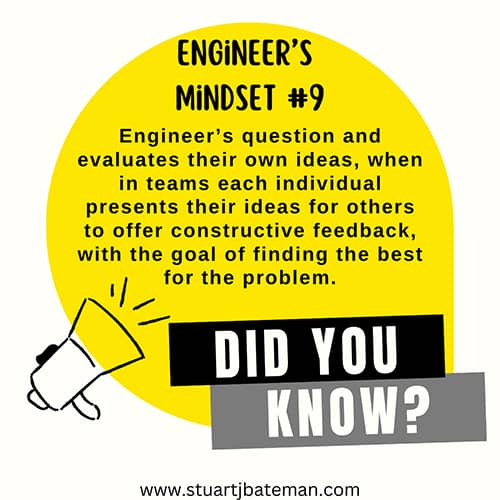
Mindset #10
Why do engineers stick to the facts? – can’t you just wing it?
Engineers rely on the scientific method as our guiding light—it’s the cornerstone of our approach.
Here’s how it unfolds:
- Observation/Questioning: We start by observing and questioning the situation or problem at hand.
- Research: We dive into the topic area, studying past examples and results.
- Hypothesis: We formulate hypotheses about what might be occurring and propose potential solutions.
- Testing: We implement rigorous methods to test these solutions.
- Analysis: We analyse the data collected during testing and draw conclusions based on empirical evidence.
- Peer Assessment: We subject our conclusions to peer review for further validation.
But amidst this structured approach, we aware of Facts, Opinions, and Guesses (FOG).
Always prioritize working with Facts. If data is lacking, actively seek to measure, research, or test for it.
Opinions play a crucial role in evaluating solutions. Employ methods to score these ideas using results obtained from testing campaigns.
However, it’s crucial to set aside Guesses. Engineers rely on data and sound scientific principles for decision-making.
Moreover, fostering a culture of curiosity and collaboration is key. Embrace diverse perspectives and encourage open dialogue to enrich problem-solving.
Remember, engineering isn’t just about formulas and equations—it’s about creativity and innovation fuelled by a commitment to truth and accuracy.
Trial and error only gets you so far, but if you look at it even that method follows the same scientific approach.
Can you think of projects that you’ve worked on that required this train of thought?
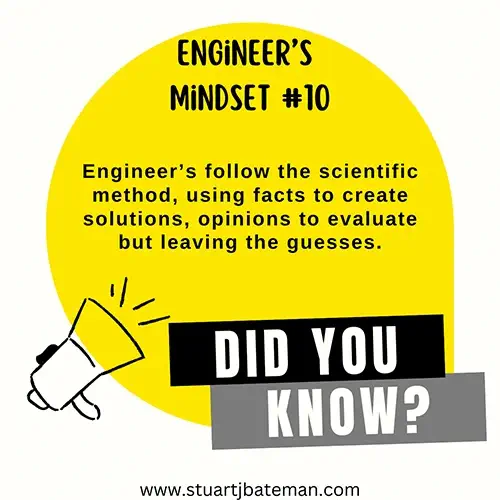
Resource – (Internal) – Personal Development
Below are links to my 5 part series on Personal development:
- Making mistakes / assumptions and being wrong
- Can you detect Baloney
- First principles thinking
- Do you think it’s better to win?
- The Socratic method – Critical thinking
Mindset #11
Somethings it’s easier to explain something while you’re holding the example…
It was difficult (and for so many), but I found it difficult to describe the problem to our supplier over the video conference call during the pandemic. “You see this area at the back under the handle….” it doesn’t quite work for engineers to describe something without everyone being in the same room and able to hold the item you’re talking about.
I don’t know about you, but as an engineer physically holding an item helps me problem solve certain issues.
CAD is great and it’s really catapulted productivity and simulation way ahead over the last 30 years, but prototyping concept solutions is still very much part of the design process.
Having the physical item in front of you allows engineers to check:
- Fit
- Function
- Form
- Defects
While checking the manufacturing capabilities and surface treatments, but then there’s the testing side as well.
Added to this is a tactile feel engineers employ to find issues like burrs, holes, geometry defects among others.
It’s almost like a secondary language that we have.
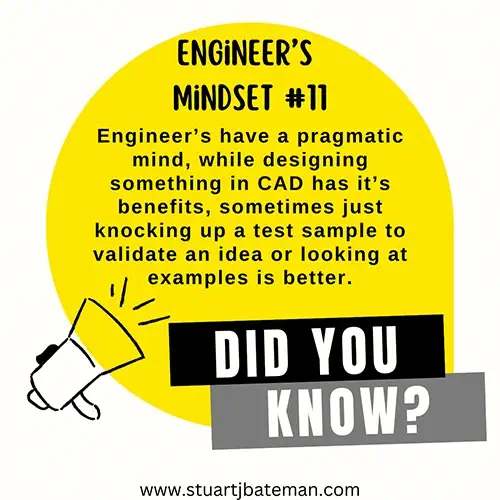
Mindset #12
In the realm of engineering, facts reign supreme. But isn’t that true for all of us?
You want to know more? Ok.
Why do engineers value facts?
- Foundation of Precision
- Risk Mitigation
- Innovation Driver
While the engineer’s dedication to facts is evident in their professional endeavours, its significance transcends the realm of engineering and impacts all professions:
Critical Thinking: Embracing facts cultivates a habit of critical thinking, essential not only in engineering but also in everyday life. It fosters informed decision-making and guards against biases and misconceptions.
Global Impact: In an era of misinformation, the ability to discern facts from fiction is more crucial than ever. Engineers, equipped with their commitment to evidence-based reasoning, play a vital role in addressing complex societal challenges.
In essence, the engineer’s reverence for facts epitomizes a commitment to excellence, integrity, and responsibility. It’s a mindset that transcends professional boundaries, shaping not only the solutions we engineer but also the way we approach life’s challenges.
So, the next time you find yourself grappling with a problem, remember: Be like an Engineer and embrace the facts, for they are the cornerstone of progress.
What are your thoughts?
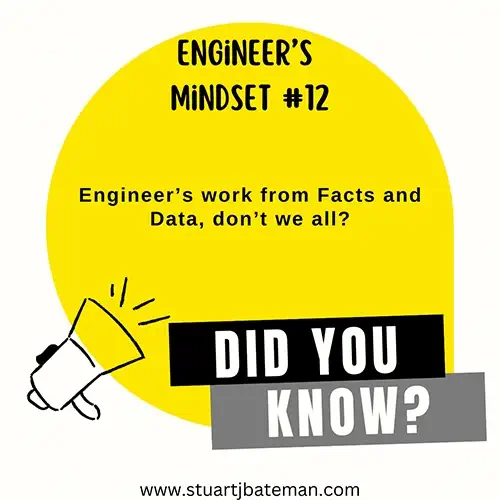
Mindset #13
Engineers embody a ‘Can Do’ belief that transcends mere optimism—it’s a fundamental principle ingrained in our approach to problem-solving.
While this mindset isn’t exclusive to engineers, it forms the bedrock of our profession.
What exactly does this ‘Can Do’ belief instil in engineers?
- Confidence in Possibility: When faced with a challenge, engineers operate under the premise that if physics allows it, then it’s merely a matter of time until a solution is devised.
- Resilience in Failure: Failures are not setbacks; rather, they are invaluable learning experiences. We embrace them as part of the journey, extracting lessons and insights to propel us forward.
- Iterative Improvement: Instead of dismissing past attempts as futile, we scrutinize failures to pinpoint areas for improvement. Every setback is viewed as an opportunity to refine our approach and build upon previous efforts.
- Innovation as a Driver: If existing technology falls short, engineers willingly embark on the path of developing new solutions. Innovation isn’t a distant goal but rather a starting point for our endeavours.
- Collaborative Spirit: Engineering is rarely a solitary pursuit. We thrive on collaboration, recognizing that the collective intelligence of a team far exceeds that of any individual. Every member’s input is valued and contributes to our collective success.
Combining this mindset with our technical prowess, we become an unstoppable force in driving progress and innovation.
It’s fascinating to note that since the early 1600s, this spirit of ingenuity has propelled us steadily forward, continually pushing the boundaries of what is possible.
Do you have a ‘can do’ mindset?
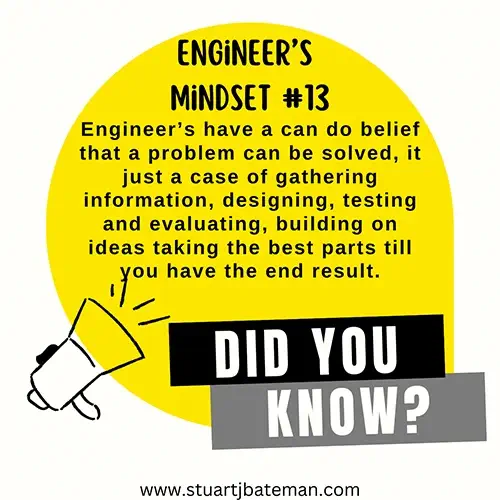
Mindset #14
I use to love playing Lemmings when I was younger, but that mindset today won’t get me anywhere, here’s an idea for you let me explain…
As engineers, we embody a delicate balance between having an open mind and a sceptical approach when it comes to exploring new ideas.
In any industry, the desire to progress and acquire new knowledge is paramount, but it’s essential to hone a skill that prevents us from hastily embracing the first notion, trend, or directive presented to us.
Carl Sagan eloquently outlined this concept in his “baloney detection kit.” Embracing new ideas is relatively straightforward when they align with our existing biases or knowledge.
However, when faced with ideas that challenge our preconceptions, scepticism naturally arises. It’s at this juncture that we must exercise an open mind, allowing the idea in and critically evaluating the evidence supporting it.
Should the evidence be compelling, we may choose to accept the idea and integrate it into our understanding. But what if the idea doesn’t directly contradict our current beliefs?
In such cases, blind acceptance isn’t the answer. Instead, we must apply scepticism, rigorously questioning the evidence presented. If the evidence withstands scrutiny, acceptance follows; if not, rejection is warranted.
This approach bears resemblance to statistical hypothesis testing, where we systematically evaluate evidence to make informed decisions.
As engineers, mastering this dual skill set is essential. It ensures that our ideas remain free from bias and are grounded in the most current methodologies, concepts, and knowledge available.
If you want to practise these skills like I do, then I encourage you to explore the links in the comments!
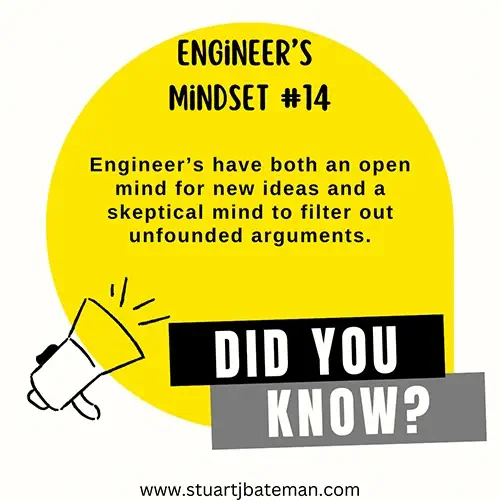
Engineer’s Mindset #15
Have you ever seen that meme asking several simple questions and ending in one of three options (WD40, Tape or do nothing)?
Navigating through challenges isn’t always straightforward for engineers.
Thankfully, there’s a multitude of resources available:
- – Institutes
- – Internet websites
- – Media sites
- – Videos
- – Books
- – Journals
- – Articles
- – Magazines
- – Case studies
- – Research studies
- – Universities
Keeping tabs on these avenues is essential for staying informed, as valuable insights can arise unexpectedly.
Moreover, applying engineering principles, exercising sound judgment, and leveraging reference materials are key in crafting effective solutions.
So, let’s not overlook the wealth of information at our disposal, including free services for knowledge refreshment (I personally check weekly).

Engineer’s Mindset #16
Are you watching that closely? Why is it that when we observe a process the truth speaks for itself
Engineers have the ability to observe, why is that?
Try watching the processes going on in your business, notice people moving about and interacting with each other, now if you can go ask them what their process is and what’s involved.
Most won’t remember every detail that you just watched them do, why?
Well, that’s because over time the motions/actions move from conscience confidence to sub-conscience confidence, what you would call ‘Muscle memory’.
You do the same while driving.
There’s another reason to watch processes or things happening, engineers are basically scientists and we observe things to define how they work, we also observe our solutions to see if they conform to predictions or we missed something.
This sounds familiar doesn’t it?
It does, because you guessed it Feynman said something similar many years ago.
“If it disagrees with experiment, it’s wrong. In that simple statement is the key to science. It doesn’t make any difference how beautiful your guess is, it doesn’t matter how smart you are who made the guess, or what his name is … If it disagrees with experiment, it’s wrong.”
Richard Feynman
So, why do we observe? To understand the nature of things, to test our understanding and to refine.

Engineer’s Mindset #17
Engineers don’t allow limits to get in the way!
Why?
- Limiting beliefs stops our creative surges
- It’s not impossible until it’s proven
- You’ll probably find 10,000 ways to do it wrong before the Eureka moment
- Only physics can say no, not people
- There are so many fields in engineering that at one point the answer will require several to solve it
- When you stop thinking about limits, past ideas will surface that could lead to the answer but were given up on before
- There are so many examples where engineers pushed past limits
- SR-71
- Blue LED
- Saturn 5
- Falcon 9
- Internet
- Concorde
- Voyager 1 + 2
- Quantum Computing
Just take a look, every engineering project that’s defined itself faced challenges and limits.
Can you think of any engineering projects?

Engineer’s Mindset #18
You may not think engineers are Artists, but we have our moments of creativity.
Engineers are among the best when it comes to thinking outside the box and coming up with solutions to a problem.
That’s great, but what do I mean by Engineers being artists?
Designing an engine doesn’t mean it has to look like a box inside another box, engineers can design concept ideas to the given restrictions.
But apart from concept designs and architects what really makes an impression to me is how well a part/assembly or solution has been designed to create functionality while adhering to restrictions and physics.
Take for example: (don’t just look at the outside, the mechanism inside are what I’m talking about)
Mechanical watches (the complexity within such a confined space)
Bugatti Veyron (the engine has more than enough to pour over)
Elizabeth line (London underground)
Ballpoint pen (see how simple it is)
Raptor 2 (the ultimate in complex designs that’s getting simpler)
It doesn’t end there, as there are hundreds of examples in building, streets, bridges, transports, robotics, satellites and more.
We don’t just solve, we create!
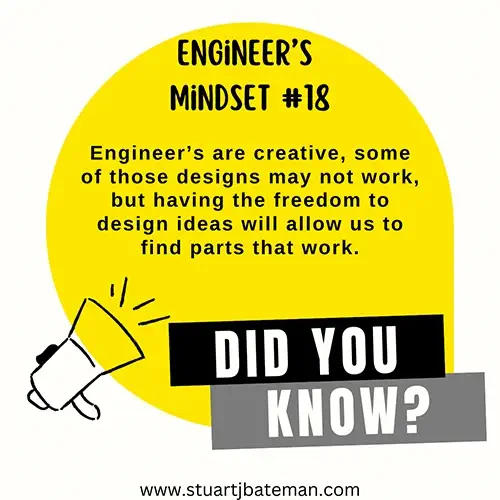
Engineer’s Mindset #19
Resilience is essential in engineering, as in any profession. But how do engineers bounce back and push forward after setbacks?
The strength often lies within the team. Together, we analyse failures, draw lessons, and adapt our strategies. Here’s how we typically regroup and refine our approach:
Key Tools We Use:
- 1. FMEA (Failure Mode and Effects Analysis) – Identifying potential failures and their impacts.
- 2. Fault Tree Analysis – Tracing back the root causes of a failure.
- 3. Ishikawa Diagram (Fishbone) – Visualizing causes and effects to identify sources of error.
- 4. 5 Whys – A simple but powerful method to get to the root of a problem.
- 5. Team Reviews and Discussions – Collaborative reflections that foster collective insights and solutions.
Following the application of these tools, we draft an action plan. We prioritize tasks based on their impact, focusing first on areas most contributing to the failure. It’s crucial to change one variable at a time in subsequent tests. This approach helps pinpoint what exactly influences outcomes, avoiding confusion from too many simultaneous changes.
Have you employed any of these tools in your projects? How do you recover from setbacks and drive success?

and finally Engineer’s Mindset #20
Without which, how do we know the facts?
It might be obvious to some and not so to others, but Engineers use quite a bit of Maths and Statistics.
Both enable us to:
- Translate the real world into formulas that we apply logic to understand
- Enable us to find relationships
- Once understood it can be taught to other engineers to enable them to skip onto the next problem
- Enables engineer’s to bridge all language barriers (and industries too!)
- Allows us to check each other’s work
There are more benefits, can you think of any?
That’s the last of the mindset list I had for engineers, from the response I’ve had it looks like many share the same thoughts so I would encourage you to teach the next generation the mindset they need to become engineers.
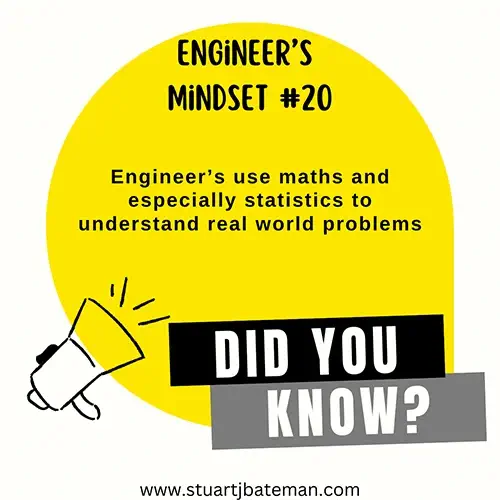


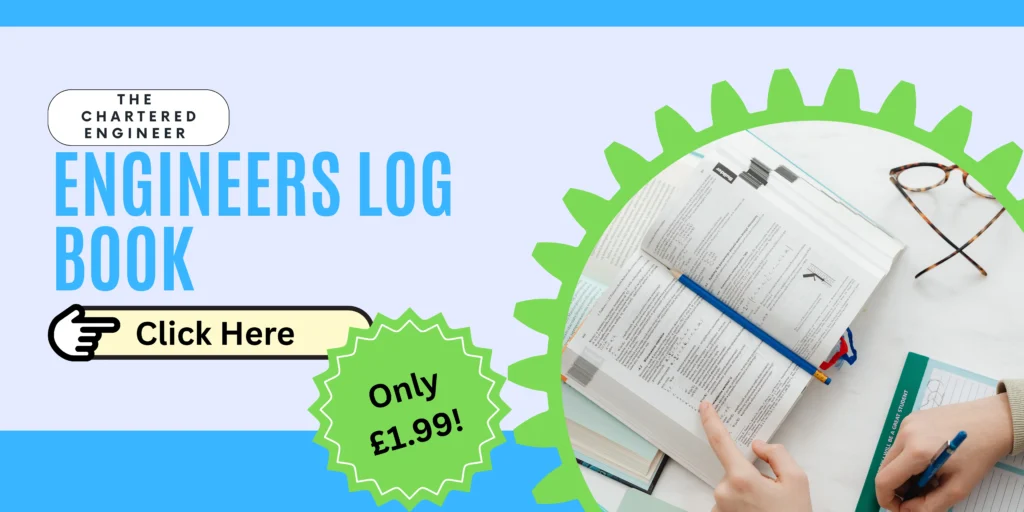
What are your thoughts? Have I covered everything or is there more you know and would like to share?
I’m always learning and improving this site and my blogs, so please feel free to get in touch with me via LinkedIn or this site to discuss any topics I have covered.
If you’re having trouble finding ways to progress check out these sites filled with free learning tools:


Discover more from The Chartered Engineer
Subscribe to get the latest posts sent to your email.